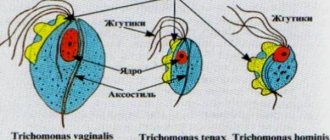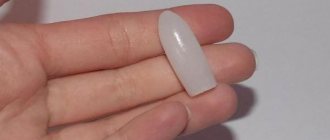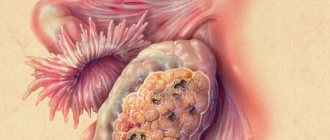Reasons for the development of vaginal candidiasis
The main etiological factor in the development of vulvovaginal candidiasis is infectious inflammation caused by fungi of the genus Candida. This genus includes about 150 species of fungal microorganisms, but 80% of all recorded episodes of vaginal candidiasis are caused by the fungal microorganisms Candida albicans. The remaining cases of thrush are due to infection with C. glabrata and C. tropicans.
Normally, fungal organisms of the genus Candida can be found in the gastrointestinal and genitourinary tracts of humans: in the large intestine, fungi of the genus Candida are found in 50% of healthy people, in the oral cavity - in 30-70% of people, in the vagina - 10-15% of healthy women. In small quantities, the fungus does not cause inflammation, since local immune factors and beneficial microflora of the vaginal mucosa inhibit the growth of fungal colonies. In some cases, this balance is disrupted, and Candida fungi begin to multiply intensively and increase the number of colonies, causing an infectious inflammatory process. Factors that stimulate the development of vaginal candidiasis include:
- Immunodeficiencies. Weakened immunity reduces protection against the proliferation of opportunistic organisms, including fungal microorganisms. Immunodeficiencies can be caused by taking glucocorticoids, chemotherapy drugs, surgery and vitamin deficiencies. Very often, candidiasis develops in people with congenital immunodeficiencies and AIDS.
- Long-term antibiotic therapy. The use of antibiotics for a long time (longer than 1 week) leads to the death of the beneficial microflora of the vagina. Fungal microorganisms are not sensitive to the action of most antibiotics, so they begin to multiply intensively, which leads to the development of thrush of various localizations (vaginal, intestinal, oropharyngeal candidiasis).
- Diabetes. Patients with diabetes have increased levels of sugar in the blood and tissues, which creates a good environment for the proliferation of fungi of the genus Candida. In addition, with diabetes, the level of local immunity decreases, which also leads to uncontrolled proliferation of candida.
- Hormonal disorders in women. An increase in estrogen levels leads to increased proliferation of the fungus.
- Pregnancy. An increase in the level of progesterone and globulins in the blood, a violation of local immunity factors in the vagina during pregnancy increases the risk of developing candidal infection. According to statistics, 40-60% of pregnant women have had an episode of vulvovaginal candidiasis during pregnancy.
- Use of oral contraceptives. Oral contraceptives are hormonal drugs and their use leads to an increase in the level of female hormones, and, therefore, increases the risk of developing vaginal candidiasis.
- Sexual contacts. Vaginal candidiasis cannot be classified as a sexually transmitted infection, but sexual intercourse contributes to the introduction of fungal mycelium into the vagina.
- Failure to comply with personal hygiene rules.
- Wearing tight clothes. In women who wear tight clothes, the temperature in the folds of the skin increases, which is a favorable condition for the growth of fungus.
In newborn children, candidiasis can develop due to infection with candida during the genital tract of a sick mother. Therefore, women who are planning a pregnancy are recommended to have vaginal candidiasis diagnosed and, if necessary, decontaminate the pathogen.
How and why is thrush dangerous if it is not treated and does not get rid of it in time?
It has been said here more than once that candidiasis can cause or be a consequence of a more serious and dangerous disease. What can cause thrush has already been said above, now we list what the consequences and complications are:
Thrush can lead to:
- complications during pregnancy. Candidiasis during pregnancy is more difficult to treat, so it is necessary to get rid of thrush as early as possible - before pregnancy, at the first signs of the disease. This will save you from problems during a future pregnancy.
- complications such as infections of the urinary tract and kidneys.
In particularly serious cases, the fungus may begin to spread to internal organs. This is a more severe form of the disease, which already makes itself felt with serious and unpleasant symptoms. Treating this form of thrush is not as easy as the usual one.
But don’t be afraid: our doctors know how to cure thrush. The main thing is to seek help in time. We remind you once again that this can be done by calling the phone number listed on this page.
Symptoms of vaginal candidiasis
The symptoms of vaginal candidiasis are quite typical, which makes it easy to distinguish thrush from other diseases of the female external genitalia. We can distinguish a group of symptoms that appear with vaginal candidiasis in different variations:
- Vaginal discharge. Classic vaginal discharge in the form of white plaques that adhere tightly to the mucous membrane, or in the form of brittle, curd-like discharge with a sour/putrid odor, is statistically found in only 20% of patients. Sometimes the discharge from thrush resembles normal vaginal discharge, only in larger quantities.
- Itching of the external genitalia and vaginal mucosa. The most common symptom of vaginal candidiasis. Develops due to infectious inflammation of the mucous membranes.
- Redness of the external genitalia. Always accompanied by itching.
- Soreness and discomfort. They are also one of the most common symptoms of thrush. Severe itching gradually turns into aching pain in the perineal area.
- Dyspareunia or pain during sexual intercourse. Mechanical irritation of the inflamed mucous membranes during sexual intercourse causes severe pain, which is why patients often refrain from sexual relations during illness.
- Pain and burning when urinating. Inflammation from the vagina spreads to the vulva and labia minora, so when urine gets on the inflamed mucous membranes, painful sensations occur.
The degree of symptoms and duration of the disease depends on the clinical form of vaginal candidiasis. There are three forms of the disease:
- Acute form of vaginal candidiasis.
- Chronic (recurrent) form of vaginal candidiasis.
- Asymptomatic candidiasis.
The manifestation of one or another form of vaginal candidiasis depends on the state of immunity and the balance of microorganisms in the vagina. In women with relatively normal immune system reactivity, asymptomatic candidiasis is most often observed. This diagnosis can be made when a bacteriological examination reveals low titres of candida (less than 104 colony-forming units/ml). This form of candidiasis is asymptomatic and is discovered by chance during the diagnosis of other diseases or during professional diagnostics.
The chronic form often develops from the acute form due to inadequate therapy. The symptoms of this form are no different from acute ones, but the manifestations are less intense. In some cases, the chronic form appears only during menstruation, while no symptoms are observed in other phases of the menstrual cycle.
The diagnosis of the chronic form of vaginal candidiasis is made when the titer of fungi of the genus Candida on the vaginal mucosa is more than 104 KUO/ml and with more than 4 cases of candidal infection over 1 year. Acute vaginal candidiasis develops when candida titers on the mucous membrane are above 104 KU/ml, and lasts less than 2 months. Symptoms in this form are most pronounced.
Episodes of vaginal candidiasis during pregnancy are observed in 20-60% of women. The course of this form of thrush is similar to the routine acute form of vaginal candidiasis.
The order and stages of treatment, or how to get rid of thrush
The beginning of your recovery begins when you decide to make an appointment with your doctor. Medical diagnostic specialists are ready to see you at any time. To make an appointment, you can call the phone number listed on the page or leave a request for a call back.
Initial examination is the first step to find out how to cure thrush
This is an important stage when the doctor examines, asks questions and receives answers to determine the extent of the damage and the duration of the disease. To understand how and with what to treat thrush, the doctor needs to take a smear and conduct a gynecological examination of the patient. In special cases, additional examinations and tests may be prescribed.
Diagnosis of the disease:
The most common method of treating thrush in women is a microscopic examination of a smear and the prescription of drugs based on the test results. But this is only in cases where the disease is diagnosed with a mild form, which requires only local exposure.
If thrush is chronic or is a relapse, then diagnosis and treatment in women requires a more detailed analysis, for example, a culture test to determine the type of fungus and treat it with stronger medications. Additional tests are also prescribed if the standard regimen is ineffective or there is a suspicion that thrush indicates the presence of another, more serious disease.
Contraindications
Treatment of any disease, despite the common causes and symptoms, is a purely individual process. Therefore, our doctors always ask the patient questions about contraindications for various procedures and intolerance to drug components.
Diagnosis of vaginal candidiasis
The first step in diagnosing thrush will be a mandatory examination by a gynecologist, since many other diseases of the female genital tract can cause inflammation, itching and discharge, so only a specialist can conduct a high-quality diagnosis and choose the right treatment. When examining the patient’s external genitalia, one can see redness and slight swelling of the labia and vestibule of the vagina, a characteristic white discharge with a fragile consistency and creeping white films.
The next stage of diagnosis will be a vaginal smear, which is performed for discharge of any etiology. The material is sent for bacterioscopic diagnostics, where the smear is stained with a KOH solution or Gram and examined under a microscope. If branched hyphae of Candida are detected, the material is sent for bacteriological diagnostics for cultivation on Sabaurauda agar and further calculation of the colony titer.
Sometimes more sensitive diagnostic methods, such as smear polymerase chain reaction, are required to confirm the diagnosis.
How to cure thrush easily and effectively
Our center offers high-quality treatment, which is based on effective and accurate diagnosis. When you turn to us for help, you are investing in your own health not only to get better, but also to avoid getting sick in the future. Find out more about diagnostic options, treatment and costs from the center staff.
Treatment plan
What is prescribed?
Thanks to the variety of remedies available today, every woman can choose a form of rapid treatment for thrush that is convenient for her (if we are talking about a mild form): antifungal medications, vaginal tablets and suppositories, anti-inflammatory creams, ointments and other methods and preparations.
As a treatment, the doctor may also prescribe a diet or diet, which may include drinking plenty of plain water, eliminating fatty, sweet and smoked foods, as well as foods high in carbohydrates.
The duration of treatment in this case is short: usually it is taken in courses, with or without breaks. The timing and set of medications is selected by the doctor individually. A follow-up appointment is required after completing the course of treatment.
Thrush in women: treatment at a secondary appointment and search for new methods
We schedule a second appointment for the patient to monitor the treatment. If the result of the re-examination and consultation with the doctor are positive, then you are discharged and sent home, having been told what chronic thrush is, what it looks like, what causes it in women, what causes relapses and how to avoid it.
If a secondary appointment (examination, re-diagnosis and tests) indicates that the treatment plan did not work, then the doctor prescribes additional examinations and selects new medications (medicines, drugs, tablets, possibly douching) for thrush. As mentioned above, thrush can serve as a signal of the presence of another disease.
results
Thrush is a rather unpleasant phenomenon in the life of any woman, but it is transient if the course of treatment is chosen correctly. The time frame for complete relief from the disease varies from person to person.
Rehabilitation
Depending on the form and nature of candidiasis and the course of treatment performed, a plan for restoring the body and a number of preventive measures are prescribed. In each specific case, this is an individual set of tools that only a good specialist can correctly select.
Prevention
How to prevent thrush rather than treat it?
Do you know what causes this disease and that you will definitely need treatment from a specialist (as a result, taking pills and douching), but you don’t know how to prevent it?
To prevent thrush from disturbing your peace, it is enough to remember a few rules:
- Wear comfortable (not tight) underwear made from natural materials (cotton, silk, etc.).
- It is advisable not to wear tight clothing (jeans, leggings, etc.) often.
- Follow the rules of personal hygiene (it is advisable to use special products for the intimate area, rather than regular soap).
- The use of deodorized toilet paper, tampons and pads, and scented soaps is also not recommended.
- Try to lead a healthy lifestyle (eating right, exercising).
- Try to support your immune system and remember that taking any medications, especially antibiotics or hormonal drugs, without the supervision of a doctor is unacceptable.
You can learn more about how to avoid becoming a victim of thrush from the medical staff. Sign up and come for a consultation! You can start taking care of your health with a simple phone call - the number is listed on the page.











